|
|
|
|
|
|
|
|
|
|
|
|
|
|
|
|
|
|
|
|
|
|
|
|
|
|
|
|
|
|
|
|
|
|
|
|
|
|
|
|
|
|
|
|
|
|
|
|
|
|
|
|
|
|
|
|
|
|
|
|
|
|
|
|
|
|
|
|
|
|
|
|
|
|
|
|
|
|
|
|
|
|
|
|
|
|
|
|
|
|
|
|
|
|
|
|
|
|
|
|
|
|
|
|
|
|
|
|
|
|
|
|
|
|
|
|
|
|
|
|
|
|
|
|
|
|
|
|
|
|
|
 |
|
|
|
|
|
|
|
|
|
|
|
|
|
|
|
|
|
|
|
 |
|
|
|
|
|
|
|
|
|
|
|
|
|
|
|
|
|
|
|
|
|
|
|
|
|
|
|
Mutilated
sculpture, once in the reredos of the north transept of St. Cuthbert's Church,
Wells. |
|
|
|
|
|
|
|
|
|
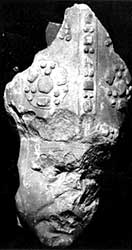 |
|
|
|
|
|
|
|
|
|
|
|
|
|
|
|
|
|
|
|
|
|
|
|
|
|
|
|
|
|
|
|
|
|
|
|
|
|
|
|
|
|
|
|
|
|
|
|
|
|
|
|
|
|
|
|
|
|
|
|
|
|
|
|
|
|
|
|
|
|
|
|
|
|
|
|
|
|
|
 |
|
|
|
|
|
|
|
|
|
|
|
|
|
|
|
|
|
|
|
|
|
|
|
|
|
|
|
|
|
|
|
|
|
|
|
|
|
|
|
|
|
|
|
|
 |
|
|
|
|
|
|
|
|
|
|
|
|
|
|
|
|
|
|
|
|
|
|
|
|
|
|
|
|
|
|
|
|
|
|
|
|
|
|
|
 |
|
|
|
|
|
|
|
|
|
|
|
|
|
|
|
|
|
|
|
|
|
|
|
|
|
|
|
|
|
|
|
|
|
|
|
|
|
|
|
|
|
|
|
|
|
|
|
|
|
|
|
|
|
|
|
The
iconoclasm of the Henrician Reformation differed from elsewhere in Europe in
one major respect, it was inspired from above, within the royal ranks, rather
than below, as with Martin Luther. There were several serious iconoclastic incidents
throughout England but cases involved few participants and were wholly different
from the riots which destroyed images from cities in Germany, Switzerland. Henry
began to see himself in the role of an Old Testament king and wanted to bring
about a clearer understanding of God's word. His iconoclasm, like his supremacy,
was justified by an appeal to the word of God and the natural accompaniment
to this appeal was the publication of an official English bible, that would
reveal to the people the scriptural authority that he claimed in his politics.
The English Reformation cannot merely be reduced to an act of state because
royal supremacy gave the king not only the power but the duty to advance the
Protestant religion within his realm. |
|
|
|
|
|
|
Head
of a Bishop, a mutilated sculpture from Winchester Cathedral. |
|
|
|
|
|
|
|
|
|
|
|
|
|
|
|
|
|
|
|
|
|
|
|
|
|
|
|
|
|
|
|
|
|
|
|
|
|
|
|
|
|
|
|
|
|
|
|
|
|
|
|
|
|
|
|
|
|
|
|
|
|
|
|
|
|
|
|
|
|
|
|
|
|
|
|
|
|
|
|
|
|
|
|
|
|
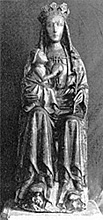 |
|
|
|
|
|
|
|
|
|
|
|
|
|
|
|
|
|
|
|
|
|
|
|
|
|
|
|
|
|
|
|
|
|
|
|
|
|
|
|
|
|
|
|
|
|
|
|
|
|
|
|
|
|
|
|
|
|
|
|
|
|
|
|
|
|
 |
|
|
|
|
|
|
Altars, Shrines &
Reliquaries
Henry
VIII took his role as head of the Church
of England seriously and his official interest turned to popular religion
and the veneration of the cult of saints, which pervaded English society.
Medieval Christianity had amplified the legends and intercessory powers surrounding
saints and martyrs until their reverence had reached a fervent pitch. An emotional
interdependence developed between the devout and their patron saints. The
worshipper adopted and revered specific saints in the hopes that they in turn
would be adopted and protected by the magical powers that were believed to
be part of the saint. |
|
|
|
|
|
|
|
|
|
|
|
|
|
|
|
|
|
|
|
|
|
|
|
|
|
|
|
Manuscript
illumination of what was once the Shrine of St. Edmund. |
|
|
|
|
|
|
|
|
|
|
Sculpture,
such as this English alabaster Virgin and Child were considered idolatrous and
therefore banned by the government. |
|
|
|
|
|
|
|
|
|
|
|
|
|
|
|
|
|
|
|
|
|
|
|
|
|
|
|
|
|
|
|
|
|
|
|
|
|
|
|
|
|
|
|
|
|
|
|
|
|
|
|
|
|
|
|
|
|
 |
|
|
|
|
|
|
|
|
|
|
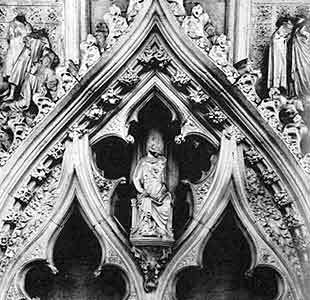 |
|
|
|
|
|
|
|
|
|
|
|
|
|
|
|
|
|
|
|
|
|
|
|
|
|
|
|
|
|
|
|
|
|
|
|
|
|
|
|
|
|
|
|
|
|
|
|
|
|
|
|
|
|
|
|
|
|
|
|
|
|
|
|
|
|
|
|
|
|
|
|
|
|
|
|
|
|
|
|
|
|
|
|
|
|
|
|
|
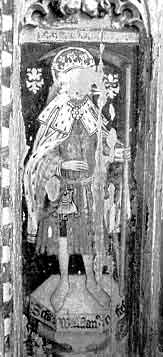 |
|
|
People
flocked to relics and shrines, especially those such as the Holy Blood of Hailes-a
crystal vial said to contain the blood of Christ and the blood of St. Thomas
Becket. Shrines, relics and images were seen as a means of seeking and giving
thanks for special favors, especially those dealing with fertility and childbirth.
Eventually it became difficult for the government to control the authority of
these shrines and the authority imbued upon them by a willing public. By the
late 1530's this worship of saints and their intercessory powers came to be
redefined as being ripe with the abuses of superstition and idolatry. Idolatry
and images were condemned with the Supremacy Act of 1532 in order that the government
and church remain in accordance with the "Word of God". This made the suppression
of the cult of saints and images a necessity because the Deuteronomic laws abolished
the veneration of idols. |
|
|
|
|
Mutilated
sculpture depicting the Life of the Virgin from the Lady Chapel of Ely Cathedral. |
|
|
|
|
|
|
|
|
|
|
|
|
|
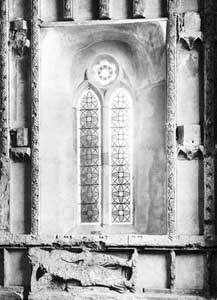 |
|
|
|
|
|
|
|
|
|
|
|
|
|
|
|
|
|
|
|
|
|
|
|
|
|
|
|
|
|
|
|
|
|
|
|
|
|
|
|
|
|
|
|
|
|
|
|
|
|
|
|
The
defaced image of St. Walstan from the south screen at Burlingham St. Andrew,
Norfolk. |
|
|
|
|
|
|
|
|
|
|
|
|
|
|
Archbishop
Cranmer maintained that all images were idols, that the definition of idol
and image meant the same thing and because all images are idols then all images
are objectionable regardless of whether they are abused with offerings and pilgrimages.
By 1541 the king had banned all images and relics to which offerings were made
on the grounds that they were the cause of superstition. Cranmer took it further
by eliminating crucifixes in order to avoid the danger of idolatry.
The second commandment was thought to be hazardous to the Christian worshipper
when dealing with representations of Jesus because an image of Christ can only
represent His human nature and not His divinity which is considered the most
important part of Him. In depicting Christ you divide Him from that what is
considered inseparable to his nature and run the risk of heresy. Images were
considered devices of the devil that were designed to distract Christians from
the true and proper worship of God. In 1538, Hugh Latimer suggested to Cromwell
that the image of Our Lady of Worcester be eradicated because "she hath been
the devil's instrument to bring many (I fear) to eternal fire ..." The superstitious
and idle worship of imagery was believed to be the result of stupidity and ignorance,
as fostered by the papacy. |
|
|
|
|
|
|
|
|
|
|
|
|
|
|
|
|
The
recling figure of Jesse was once surmounted by 21 niches containing the figures
of his descendents. All were destroyed and the projections of teh niches levelled
and plastered over. St. Cuthbert's Church, Wells. |
|
|
|
|
|
|
|
|
|
|
|
|
|
|
|
|
|
|
|
|
|
|
|
|
|
|
|
|
|
|
|
|
|
|
|
|
|
|
|
|
|
|
|
|
|
|
|
|
|
|
|
|
|
|
|
|
|
|
|
|
|
|
|
|
|
|
|
|
|
|
|
|
|
|
|
 |
|
|
|
|
|
|
|
|
|
|
|
|
|
|
|
|
|
|
|
|
|
|
|
|
|
|
|
|
|
|
|
|
|
|
|
|
|
|
|
|
|
|
|
|
|
|
|
|
|
|
|
|
|
|
|
|
|
|
|
|
|
|
|
|
|
|
|
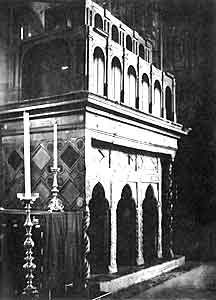 |
|
|
|
|
|
|
|
|
|
|
|
|
Major
shrines were closed down. Wealthy ones, along with famous miraculous images
were stripped and smashed. Thomas Becket's magnificent tomb at Canterbury was
despoiled, however, the shrine of Edward the Confessor at Westminster
Abbey could not be leveled because of its royal association. Because of
his edicts, Henry was forced to compromise by divesting the tomb of its rich
ornamentation and scattering its relics. From this point on, the veneration
of imagery was forbidden. "Wandering to pilgrimages, offerings of money,
candles or tapers to feigned relics or images, or kissing or licking the same,
saying over a number of beads not understood or minded on, or such like superstition,"
was denounced as tending to idolatry and the clergy was ordered to take down
images that did not comply with this decree. Sermons on pictorial representation
were considered entirely antagonistic. Regardless of whether an image was considered
a work of art or not, the object was not judged to be more or less worthy of
destruction in the opinion of the iconoclast. All such visual products of earlier
religious enthusiasm were consigned to the category of idols and seen to represent
the hated heritage of papistry. There was also a fear that, under the thin veneer
of public veneration for Christian shrines and relics lay a hint of rural paganism. |
|
|
|
|
|
|
|
|
|
|
|
|
|
|
|
|
|
|
|
The
Shrine of Edward the Confessor, Westmenster Abbey, London. The wooden structure
atop the shrine replaced the monument that was detroyed. |
|
|
|
|
|
|
|
|
|
|
Archbishop
Cranmer believed that images were so tainted with idolatry that they had to
be eradicated from English churches. Images were considered unreal and therefore,
false. Only the word of God could be trusted as real. Images and statuary from
religious houses were torn down, while paintings were whitewashed and covered
with text from English translations of the Old and New Testament. It was believed
that men should redirect their attentions to the inward presence of God's grace
as externalized in the Scripture, rather than rely on misleading images. The
word of God was the most important way for men to realize religious truths.
According to the official homilies of the Church of England, the "seeking
out of images is the beginning of whoredom." God's commands, as contained
in Biblical passages such as the second commandment, should take precedence
over the human desire for visual aids. Throughout the Reformation, Cranmer had
placed his trust in the Scripture as the ultimate criterion for Christian belief. |
|
|
|
|
|
|
|
|
|
|
|
|
|
|
|
|
|
|
|
|
|
|
|
|
|
|
|
|
|
|
|
|
|
|
|
|
|
|
|
|
|
|
|
|
|
|
|
|
|
|
|
|
|
|
|
|
|
|
|
|
|
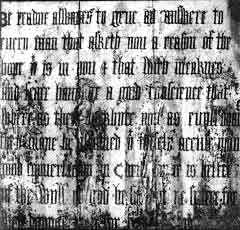 |
|
|
|
|
|
|
|
|
|
|
|
|
|
|
|
|
|
|
|
|
|
|
|
|
|
|
|
|
Detail
of the St. Mary's Priory rood screen which shows the original figures reappearing
through the whitewash. |
|
|
|
|
|
|
|
|
|
|
|
|
|
|
|
|
|
|
|
|
|
|
|
|
|
|
|
|
|
|
|
|
|
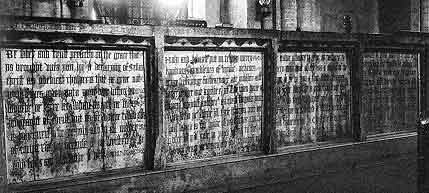 |
|
|
|
|
|
|
|
|
|
|
|
|
|
|
|
|
|
|
|
|
|
|
|
|
|
|
|
|
|
|
|
|
|
|
|
|
|
|
|
|
|
|
|
|
 |
|
|
|
|
|
|
|
|
|
|
|
|
|
|
|
|
|
|
|
|
|
|
|
|
|
|
|
|
|
|
|
|
|
|
|
|
|
|
|
|
|
|
|
|
|
|
|
|
|
|
|
|
|
|
 |
|
|
|
|
|
|
|
|
|
|
|
|
|
|
|
|
|
|
|
|
|
|
|
|
|
|
|
|
|
|
|
This base of this medieval rood screen was cut down, whitewashed, and painted
over with the text of Tyndale's translation of the New Testament. The screen
is now incorporated into the choir stalls. For Catholics the rood screen suggested
a liturgical device that separated the altar from the congregation, but Protestants
identified it with Rome and saw it as a representative of the sacrifice of
the Mass. St. Mary's Priory, Norfolk. |
|
|
|
|
|
|
|
|
|
|
|
|
|
|
|
|
|
|
|
|
|
|
|
|
|
|
|
|
|
|
|
|
|
|
|
|
|
|
|
|
The Mass
The
"rhetoric" of the papacy was presented as a debasement of Christ's teachings
and a blasphemous perversion of apostolic practice. As such it was far more
repugnant and damnable than any form of paganism. It was considered debased
and perverted because successive generations of believers had each slightly
modified the uncompromising message of Christ in order to permit the worldly
pursuit of pleasure. Protestants considered what they believed to be a tendency
towards "idol-worship" to be the most appalling aspect of Catholicism. Included
in this "idol-worship"was not simply the veneration and intercessory prayers
addressed to images of the saints and Virgin but also the ceremony of mass
where priest seemed to claim to "create" the bodily presence of God in the
Eucharist. |
|
|
|
|
|
|
|
|
|
|
|
|
|
|
|
|
|
|
|
|
|
|
|
|
|
|
|
|
|
|
|
|
|
|
|
|
|
|
|
|
|
|
|
|
|
|
|
|
|
|
|
|
|
|
|
|
|
|
|
|
|
|
|
|
|
|
|
|
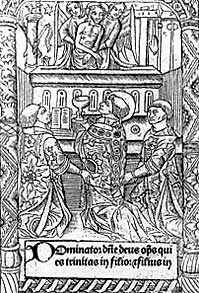 |
|
|
|
|
|
|
|
|
|
|
|
|
|
|
|
|
|
|
|
|
|
|
|
|
|
|
|
|
|
|
|
|
|
|
|
|
|
|
|
|
|
|
|
|
|
|
|
|
|
|
|
|
|
 |
|
|
|
|
|
|
|
|
|
|
|
|
|
|
|
|
|
|
|
|
|
|
|
|
|
|
|
|
|
|
|
|
|
|
|
|
|
|
 |
|
|
|
|
|
|
|
|
|
|
|
|
|
|
|
|
|
|
|
|
|
|
|
|
|
|
|
|
|
|
|
|
|
|
|
 |
|
|
|
|
|
|
|
|
|
|
|
|
|
|
|
|
|
|
|
|
|
|
|
|
|
|
|
|
The
Mass of Pope Gregory, from a Sarum primer of 1497. |
|
|
|
|
|
|
|
|
|
|
|
|
|
|
|
|
|
|
|
|
|
|
|
|
|
|
|
|
|
|
|
|
|
|
|
|
|
|
|
|
|
|
|
|
|
|
|
|
|
The
Catholic mass was more than just a representation of historic events surrounding
Christ's sacrifice.The mass was abhorrent to the new wave of Protestantism that
was sweeping the country. Reformers felt that Christ's death on the cross was
a complete and final experience and that to try and reproduce this sacrifice
within the mass was blasphemous. The mass often became the subject of ridicule,
as zealous reformers derisively referred to it as the "Jack in the Box" and
muddled the honored words of consecration "Hoc est Corpus" into "Hocus Pocus."
It was believed that the sacrament was made up of such venal and transient elements
as bread and wine, which could easily be conceived of as susceptible to idolatry.
Stephen Gardner, Bishop of Winchester, concluded that even in the sacrament
of the altar "there is not God but it is an idol". |
|
|
|
|
|
|
|
|
|
|
|
|
|
|
|
|
|
|
|
|
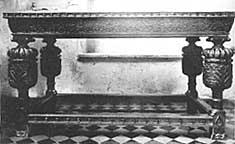 |
|
|
|
|
|
|
|
|
|
|
|
|
|
|
|
|
|
|
|
|
|
|
|
During
the reign of Edward VI altars were replaced by wooden communion tables, which
became known as the Lord's Board. |
|
|
|
|
|
|
|
|
|
|
|
|
|
|
|
|
|
|
|
|
|
As the popularity
of the mass was extremely high among the laity, reformers could not completely
abolish it and sought to transform it by manipulating the language in favor
of a more simple, vernacular Protestant ideology. Instead of reciting that the
blood and body of Christ, as represented by the bread and wine, were to "become
unto us," the words were modified to "that they may be unto us." While the former
phrase defines the alteration in the nature of the bread and wine, the latter
expresses them as nothing more than symbols which imply that this service is
a sacrifice only for the purpose of expressing praise and thanksgiving. |
|
|
|
|
|
|
|
|
|
|
|
|
|
|
|
|
|
|
|
|
|
|
|
|
|
 |
|
|
|
|
|
|
|
|
|
|
|
|
|
|
|
|
|
|
|
|
|
|
|
|
|
|
|
|
|
|
|
|
|
|
|
|
|
|
|
|
|
|
|
|
|
|
|
|
|
|
|
|
|
|
|
|
|
|
|
|
|
|
|
|
|
|
|
|
|
|
|
|
|
|
|
|
|
|
|
|
|
|
|
|
|
|
|
|
|
|
|
|
|
|
|
|
|
|
|
|
|
 |
|
|
|
|
|
|
|
|
|
|
|
|
|
|
|
|
|
|
|
|
|
|
|
|
|
|
|
|
|
|
|
|
|
|
|
|
|
|
|
|
|
|
|
|
|
|
|
|
|
|
|
|
|
|
|
|
|
|
|
|
|
|
|
|
|
|
|
|
|
|
|
|
|
|
|
|
|
|
|
|
|
|
|
|
|
|
|
|
|
|
|
|
|
|
|
|
|
|
|
|
|
 |
|
|
|
|
|
|
|
|
|
|
|
|
|
|
|
|
|
|
|
|
|
|
|
|
|
|
|
|
|
|
 |
 |
 |
 |
 |
 |
 |
 |
 |
 |
 |
 |
 |
 |
 |
 |
 |
 |
 |
 |
 |
 |
 |
 |
 |
 |
 |
 |
 |
 |
 |
 |
 |
 |
 |
 |
 |
 |
 |
 |
 |
 |
 |
 |
 |
 |
 |
 |
 |
 |
 |
 |
 |
 |
 |
 |
 |
 |
 |
 |
 |
 |
 |
 |
 |
 |
 |
 |
 |
 |
 |
 |
 |
 |
 |
 |
 |
 |
 |
 |
 |
 |
 |
 |
















